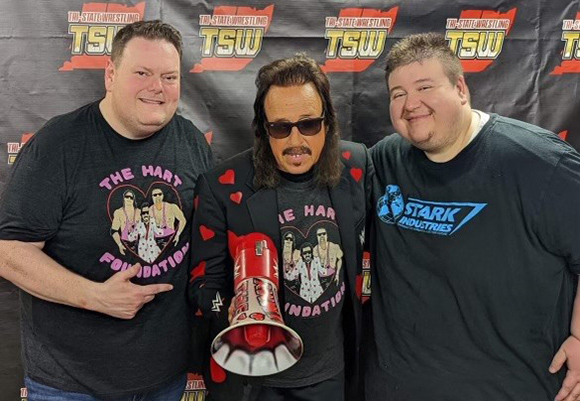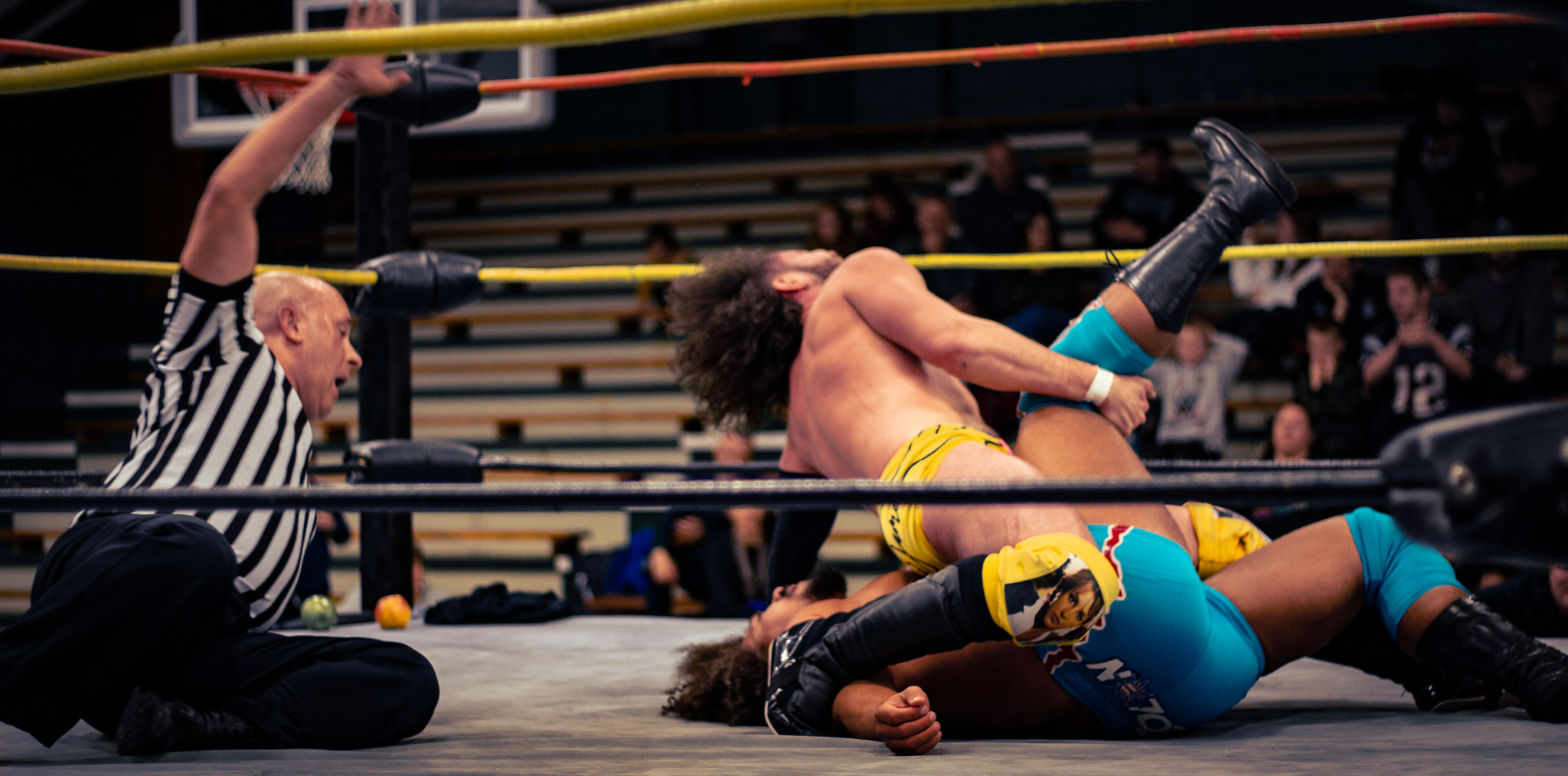One of my earliest and most vivid memories as a kid involved pro wrestling – and I’ve been a fan ever since.

Growing up in rural Southeast Indiana, we didn’t see many shows or celebrities come to our area. But on one special night when I was about six years old, the World Wrestling Federation came to nearby Lawrenceburg High School. I begged to attend, but since neither my parents nor my older sister were all that enthused about the prospect, one of my sister’s high school friends was my ride to the show. None of that mattered after we arrived at the gym, as I was immediately enthralled by the amazing sight of the wrestlers up close along with the glitz and glamour of the entire showcase.
For the main event, a big, burly man named the Junkyard Dog headed to the ring amid raucous cheers from the crowd, ready to take care of business. I managed to navigate my way over to the aisle and as JYD came by somehow he found my hand among the many outstretched arms and slapped me “five.” A big smile spread across my face.
In that moment, I was hooked for life.
Although my fandom ebbed and flowed a bit as I grew up, by my high school years in the late 1990s I was as passionate a fan as ever. Not only did I enjoy watching as a fan, I was interested in the behind-the-scenes aspects as well. Having been “smartened up” about wrestling – learning how the results are predetermined and such – I wanted to be on the inside, working with the wrestlers on developing their characters and creating storylines for TV.
My best friend Logan Cummins – also a Mount grad – had that opportunity with a smaller, independent company here in Cincinnati, the Heartland Wrestling Association (HWA). Logan worked there as a creative writing co-op while at the Mount, and owner Les Thatcher was impressed enough to bring him onto the staff for several years afterward.
Logan and I always wanted to work together creatively in wrestling and dreamed of one day running our own promotion, but “real life” sent us in different directions. He and his wife Liz moved to Chicago for job opportunities, and I pursued another sports avenue with the Cincinnati Reds, where I’ve worked in the Marketing and Communications department for nearly two decades. The dream felt like it would always be just that, and I was reluctantly okay with it.
Until the spark came alive again.
The number of independent wrestling shows and promotions has increased the last couple of years as wrestlers have looked to make up for lost time from the pandemic. Logan and I decided, if we were ever going to give this a shot, the time was now. We could use Logan’s connections from his previous time in the business with HWA to get started and hopefully build up a promotion from there. No matter whether we succeeded or failed, we would always be able to say we tried.
The first order of business was deciding on a location, and we found the perfect venue in Versailles, Ind. The Tyson Activity Center was a former high school gym with plenty of bleacher seating for general admission and room for floor seats around the ring. Combine that with a stage area, great acoustics and a locker room area for the wrestlers and we were sold. And with Versailles being a small town near where we grew up, we knew how special it would be to have a wrestling show come to their neck of the woods.
We recognized right away that a key to making the event successful would be to ingratiate ourselves with the local area. We wanted to make sure they knew we were not just coming to make a buck, but that we wanted to bring a fun, family-friendly event to Versailles and be part of the community. We reached out to small businesses and formed partnerships to help sell tickets and promote our event. One of our referees was from a nearby high school, so we pitched a profile story to a local newspaper. We even made sure to have a presence at the Versailles farmers markets on Saturdays to show our commitment to making this a true grassroots effort.
Of course, no show could take place at all without talent, and we only had one chance to make a good first impression. With that in mind, we targeted a relatively big name for our first show: former WWE star Carlito. In booking someone of Carlito’s stature, we wanted to capitalize on his star power to help our bottom line by selling meet and greet opportunities for photos and autographs in addition to event tickets. Most wrestlers on the independent scene are not quite big enough names to generate that kind of interest, but Carlito’s run on TV with the WWE for several years made him much more of a household name for wrestling fans.
Beyond Carlito as our top attraction, we had to balance between talent that could put on a good show and draw interest and also managing our budget since we had no prior data to really know what kind of revenue we could generate. We could have booked several more well-known names hoping it would result in ticket sales, but we knew we needed to take a conservative approach and set some reasonable spending limits.
Along the way, we realized just how much work went in to creating this business and running a live event. We created an LLC to run our shows under and protect ourselves from any issues and researched the appropriate insurance we would need to have to cover any injuries to the talent or fans. We reached out to various contacts to hire everything from a DJ to play music throughout the night and a ring announcer to make all the introductions to renting another local promoter’s ring to use.
As we put tickets on sale and began serious promotion for the show, our backgrounds in marketing, advertising and PR came in very handy. We created social media handles to begin the early push and attract followers from other groups and promotions. Knowing the dynamic of most wrestling fans and particularly those folks in Southeast Indiana, paid Facebook ads became our primary tool to drive tickets early. Then, we supported that by scheduling a couple of local media interviews with Carlito and spending on radio and community newspapers in the area, knowing those outlets still maintain importance in small towns.
With the show approaching, the time came for us to do what we really enjoyed – developing the creative for the event, i.e. determining the winners and losers of the matches and any storylines we wanted to carry out during the show. We focused on a handful of the talents who we felt could return for us down the line and made sure they would look great. Not knowing exactly when our next show might be, we avoided any cliffhanger type endings and kept the results fairly basic with mostly the “good guys” winning in the end to send the crowd home happy.
On the day of the show, my nerves were all over the place. A couple months prior I was “just a fan” and now I stood in the middle of a locker room giving our team of wrestlers a pep talk before breaking off to get individual guys together to talk through their matches. This “producer” role is critical in making sure the talents understand what our expectations are and that each match has its own unique story and ending. Think of it as a script reading that screenwriters or playwrights would go through with actors on a movie set or in a theater.
Finally, the bell rang at 7 p.m. and the wrestlers in the opening contest made their way to the ring to kick things off. As I looked around the Tyson Activity Center at the approximately 300 fans in attendance and the match beginning in the ring, I couldn’t help but smile and shake my head in disbelief. Much like the aftermath of my “high five” with JYD, I was in awe.
We were running a wrestling promotion. Tri-State Wrestling was born.

In top photo: Wrestling ref and two contestants from Jarrod Rollins' and Logan Cummins' first match in February.
Jarrod Rollins was a columnist and editor of ‘Dateline’ in 2002 and 2003.
He started with the Cincinnati Reds as a communications/writing co-op in January 2003 and was hired full-time in February 2004. Over the years, his role has evolved from being the team's main writer/editor for editorial and marketing needs to taking on management of the website and email content/strategy to now being Senior Director of Communications. In this role, he helps oversee all aspects of our PR/marketing messaging and strategy, working closely with Creative/Design, Social Media and Advertising.

